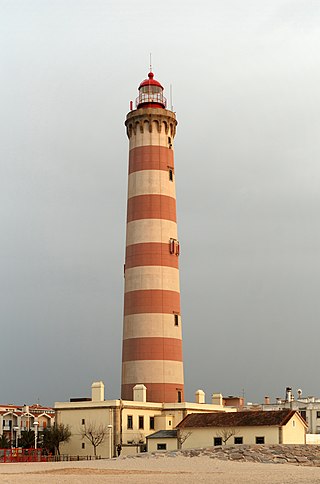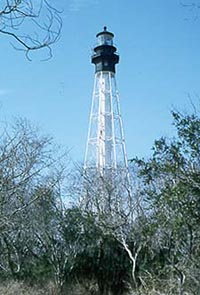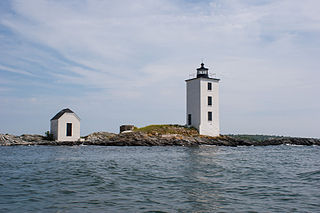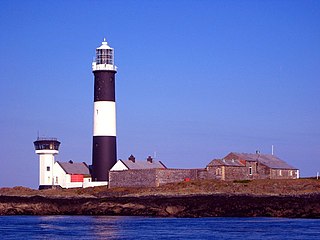
A lighthouse is a tower, building, or other type of physical structure designed to emit light from a system of lamps and lenses and to serve as a beacon for navigational aid, for maritime pilots at sea or on inland waterways.
St. George is a neighborhood on the northeastern tip of Staten Island in New York City, along the waterfront where the Kill Van Kull enters Upper New York Bay. It is the most densely developed neighborhood on Staten Island, and the location of the administrative center for the borough and for the coterminous Richmond County. The St. George Terminal, serving the Staten Island Ferry and the Staten Island Railway, is also located here. St. George is bordered on the south by the neighborhood of Tompkinsville and on the west by the neighborhood of New Brighton.

Execution Rocks Light is a lighthouse in the middle of Long Island Sound on the border between New Rochelle and Sands Point, New York. It stands 55 feet (17 m) tall, with a white light flashing every 10 seconds. The granite tower is painted white with a brown band around the middle. It has an attached stone keeper's house which has not been inhabited since the light was automated in 1979.
The Sands Point Lighthouse is located in the Incorporated Village of Sands Point in the Town of North Hempstead, in Nassau County, on the North Shore of Long Island, in New York, United States. The fourth lighthouse to be established on Long Island, this 1809 stone tower was built by an American Revolutionary War veteran who stayed on as its first keeper for many years. The Lighthouse is sometimes referred to the Mitchell Lighthouse, after Samuel L. Mitchell, the man who fought for it to be constructed.

Throgs Neck Light in Throggs Neck, the Bronx, New York, was a wooden lighthouse that was replaced by an iron skeletal tower that is still there. The lighthouse protects ships in the Long Island Sound from running up against the rocks.

Fort Wadsworth is a former United States military installation on Staten Island in New York City, situated on The Narrows which divide New York Bay into Upper and Lower halves, a natural point for defense of the Upper Bay and Manhattan beyond. Prior to closing in 1994 it claimed to be the longest continually garrisoned military installation in the United States. It comprises several fortifications, including Fort Tompkins and Battery Weed and was given its present name in 1865 to honor Brigadier General James Wadsworth, who had been killed in the Battle of the Wilderness during the Civil War. Fort Wadsworth is now part of the Staten Island Unit of Gateway National Recreation Area, maintained by the National Park Service.

Great Captain Island Lighthouse is a lighthouse on Great Captain Island in the western Long Island Sound off the coast of Greenwich, Connecticut, United States. Built in 1829, the first lighthouse, made of stone, was of such poor construction that the walls were severely cracked a decade later. In 1868, a new granite dwelling with attached lantern was completed. The lighthouse is of the same design as lighthouses at Sheffield Island in Norwalk; Morgan Point in Noank; Old Field Point Light and Plum Island in New York; and Block Island North in Rhode Island. In 1890, a fog whistle was added, in 1905 a siren was installed. The lighthouse was deactivated in 1970 when a skeletal tower replaced it. The Town of Greenwich acquired the property in 1973 and had full-time caretakers on the site until the lighthouse became too dilapidated in 2003. A successful restoration effort was completed in 2009 and a non-navigational light was activated in 2012. In 2010, a memorial plaque was installed to "honor the 23 people who lived in Greenwich, or had a connection to the town", who died in the September 11, 2001 attacks. In 1991, the Great Captain Island Light was added to the National Register of Historic Places.

Cape Charles Lighthouse is an octagonal cast iron skeleton tower lighthouse at the mouth of the Chesapeake Bay on Smith Island which was officially removed from service in 2019. It is the tallest lighthouse in Virginia and the second tallest in the United States. This particular tower is the third lighthouse at this location. The first lighthouse at Cape Charles was a 55-foot (17 m) masonry tower completed in 1828. It was quickly deemed inadequate for its important seacoast location due to its low height and poor visibility at sea. It was soon threatened by erosion so in 1864 it was replaced by a 150-foot (46 m) masonry tower built further inland. Located a little more than a mile southwest of the old tower and 600 feet from the shoreline, the impressive 150-foot-tall conical brick tower was similar in appearance to the 1857 Cape May Lighthouse, painted white and topped with a dark brown lantern room. In 1892, a twenty-five-foot red band was painted around the white tower's midsection, about sixty feet up from the base, to make it more visible during the day. By the 1890s, it too was threatened by beach erosion which jetties built to protect it failed to halt, and with the lighthouse now only 300 feet from the ocean and the shoreline eroding at a rate of 37 feet per year it was decided that a third lighthouse needed to be built three quarters of a mile inland.

The Staten Island Range Light, also known as the Ambrose Channel Range Light, is the rear range light companion to the West Bank Lighthouse. Built in 1912, the 90-foot tower sits more than five miles northwest of the West Bank Lighthouse, on Staten Island’s Richmond Hill, 141 feet above sea level. It shows a fixed white light that can be seen for 18 miles, by all vessels bound to New York and New Jersey Ports coming in from the Atlantic Ocean.

Dutch Island Light is a historic lighthouse on Dutch Island off Jamestown, Rhode Island.

McGulpin Point Light was constructed as a navigational aid through the Straits of Mackinac. The light began operation in 1869, making it one of the oldest surviving lighthouses in the Straits. Only in operation until 1906, the light is located on McGulpin Point,, approximately 3 miles (4.8 km) west of Fort Michilimackinac.

Point Clark Lighthouse is located on in a beach community, Point Clark, Ontario, near a point that protrudes into Lake Huron. Built between 1855 and 1859 under the instructions of the Board of Works, Canada West, it is one of the few on the Great Lakes to be made primarily from stone. It is one of the Imperial Towers, a group of six nearly identical towers built by contractor John Brown for the "Province of Canada" on Lake Huron and Georgian Bay, all completed by 1859. The location for the Point Clark lighthouse was selected to warn sailors of the shoals (sandbars) 2 miles (3.2 km) off the Lake Huron coast. It is still functioning as an automated light. A restoration that eventually exceeded $2.3 million started in 2011 and the facility reopened for tourism in June 2015.

Battery Weed is a four-tiered 19th century fortification guarding the Narrows, the main approach from the Atlantic Ocean to New York City. Located on the Staten Island waterfront on the west shore of the Narrows, directly across from Fort Hamilton and the now-destroyed Fort Lafayette in Brooklyn, the fort was intended to protect New York from attack by sea. When built, it was named Fort Richmond, as was a previous fort on the site.

Fort Tompkins is a fort on Staten Island in New York City, within what is now Fort Wadsworth at the Narrows. Fort Tompkins guarded the landward approaches to other forts in the area from 1808 through circa 1898. The current fort was built 1847–1861, and was operational as a fort until superseded by new defenses circa 1898. It is now part of the Gateway National Recreation Area. It is the last remaining of four forts in New York State named Fort Tompkins.

Fort Wadsworth Light is a 1903 lighthouse built atop Battery Weed on Staten Island in New York Harbor. The light illuminates the Narrows, the entrance to the harbor. It is located under the Verrazzano-Narrows Bridge. Fort Wadsworth Light was part of the transfer of Fort Wadsworth from the Navy to the National Park Service in March 1995 as part of Gateway National Recreation Area.

Blackwell Island Lighthouse, now known as Roosevelt Island Lighthouse, also was known as Welfare Island Lighthouse, is a stone lighthouse built by the government of New York City in 1872. It is within Lighthouse Park at the northern tip of Roosevelt Island in the East River. It was named to the National Register of Historic Places on March 16, 1972 and was designated a New York City Landmark on March 23, 1976.

Malören is an island in the Kalix archipelago of northern Sweden. It lies to the southwest of Sandskär, but is not part of the Haparanda Archipelago National Park. Malören has the shape of an atoll, with sandbanks around an inland sea. It came into existence about 1,500 years ago when the area began to rise by 85 cm (33 in) per century. Since 1997, the island has been a nature reserve, encompassing 181 ha. On the island is a chapel, built in 1769, and a lighthouse, built in 1851.

Eeragh Lighthouse is an active lighthouse located on Rock Island, one of the Brannock Islands, part of the Aran Islands archipelago in County Galway, Ireland. It marks the north-western entrance to Galway Bay and the port of Galway known as the North Sound. Due to its location it is also known as the Aran North Lighthouse. The lighthouse on Inisheer at the south-eastern end of the islands was also constructed at the same time. Eeragh and Inisheer both became operational in 1857.

Mew Island Lighthouse is an active lighthouse within the Copeland Islands of County Down in Northern Ireland. The current 19th-century tower is the most recent in a series of lighthouses that have been built in the islands, which have helped to guide shipping around the archipelago and into Belfast Lough.

The isle of Lundy has three lighthouses: a pair of active lights built in 1897 and an older lighthouse dating from 1797.



















